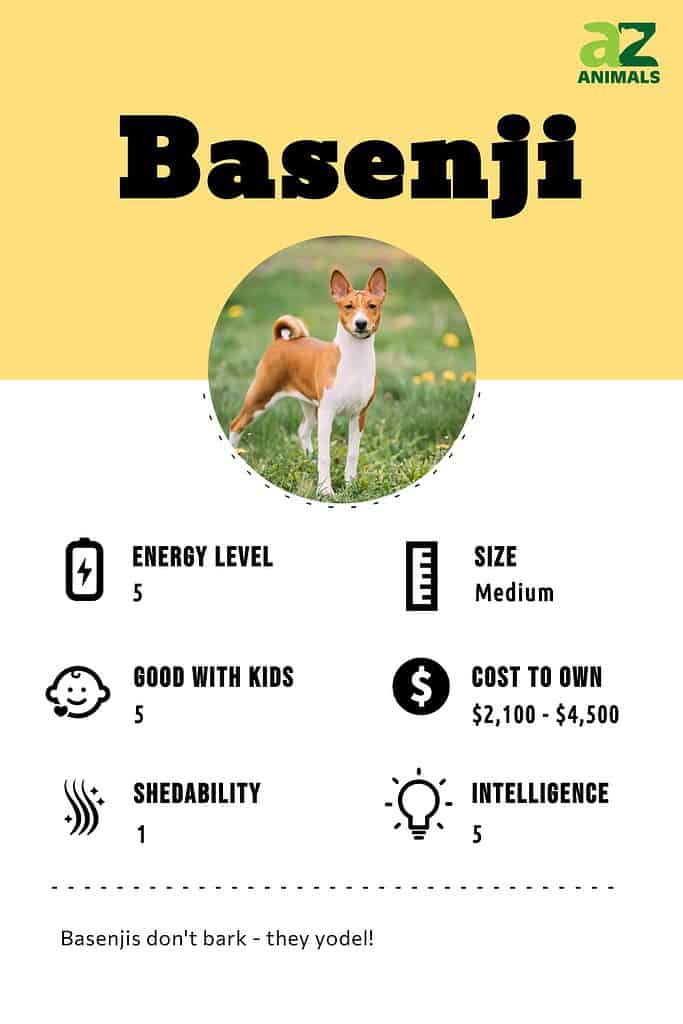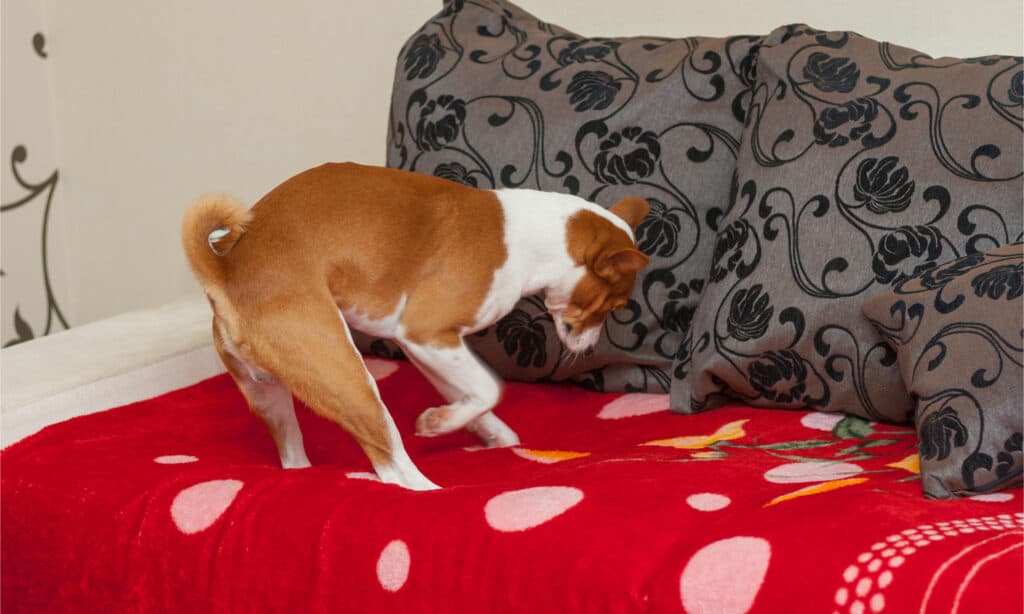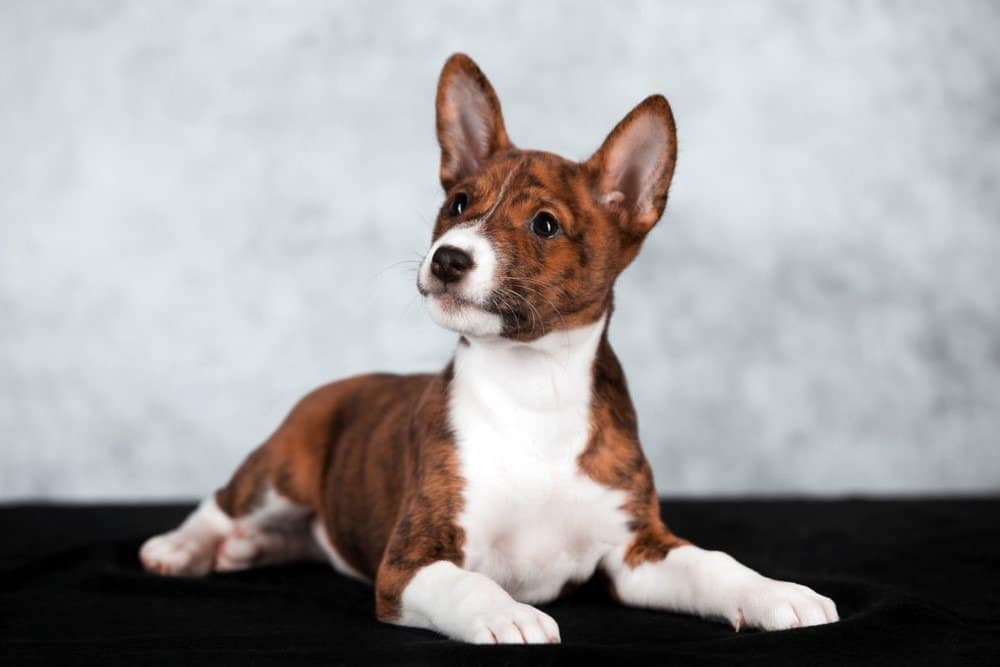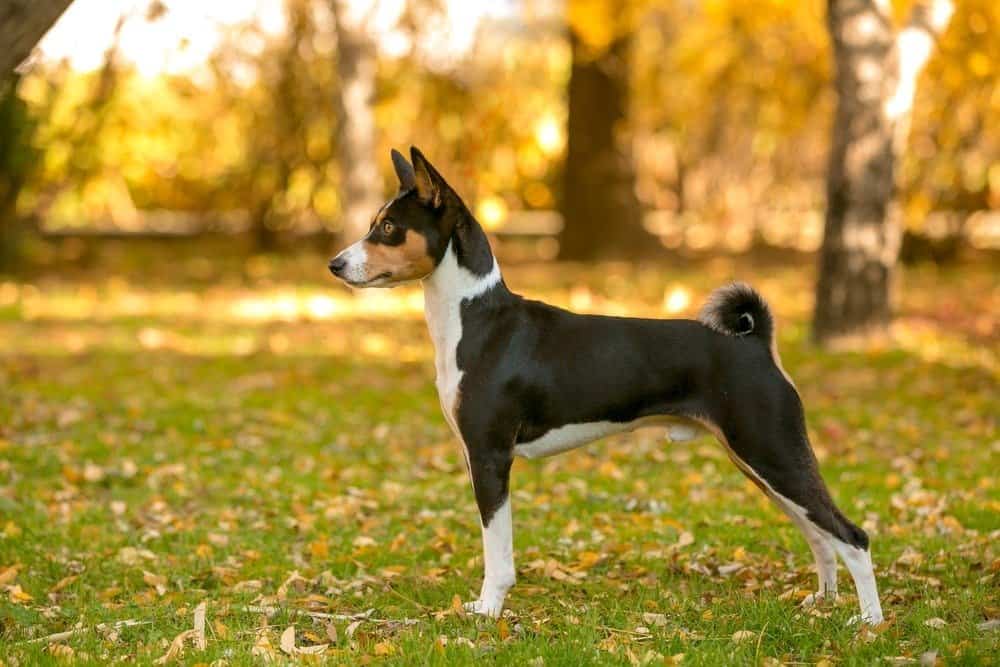Basenji Dog
Canis lupus
Alert, affectionate and energetic!
Advertisement
Basenji Dog Scientific Classification
- Kingdom
- Animalia
- Phylum
- Chordata
- Class
- Mammalia
- Order
- Carnivora
- Family
- Canidae
- Genus
- Canis
- Scientific Name
- Canis lupus
Read our Complete Guide to Classification of Animals.
Basenji Dog Conservation Status
Basenji Dog Facts
- Temperament
- Loyal, stubborn, and affectionate
- Training
- Should be trained from an early age as their independent nature can make them stubborn
- Diet
- Omnivore
Basenji Dog as a Pet:
- General Health
- Energy Level
- Shedability
- Trainability
- Intelligence
- Tendency to Chew
- Size
- Family and kid friendliness
- Yappiness / Barking
- Silent
- Hypoallergenic
- Yes
- Separation Anxiety
- Moderate
- Preferred Temperature
- Average climate
- Exercise Needs
- High
- Friendly With Other Dogs
- Moderate
- Pure bred cost to own
- $2100 to $4500
- Dog group
- Working
- Male weight
- -24 lbs
- Female weight
- -22 lbs
This post may contain affiliate links to our partners like Chewy, Amazon, and others. Purchasing through these helps us further the A-Z Animals mission to educate about the world's species.
View all of the Basenji Dog images!
The Basenji Dog is known as a “barkless” dog, but they aren’t exactly quiet either.
Bred to be hunting dogs in central Africa, Basenjis are believed to be one of the first domesticated dogs. The name “Basenji” means dog of the bush – referring to the African bush of their origin. These unusual, graceful, canines are medium-sized with shiny coats and curly tails. Their foreheads are cute and wrinkly and their eyes are uniquely almond-shaped.
See all of our expert product reviews.

They are known as “barkless” dogs, but they aren’t exactly quiet either. Instead, they express themselves through various noises, like yodeling. In fact, these dogs can be quite vocal, ensuring that their owner always knows what is on their mind. They are known as a “cult” breed and are usually small in numbers. Basenji are considered to be hypoallergenic which means that they do not shed at all, due to their breeding.
3 Pros and Cons of Owning Basenji Dogs
| Pros! | Cons! |
|---|---|
| Elegant: These dogs are very elegant and poised. Their graceful figure is aesthetically beautiful, featuring a strong and smooth build. | Needs a lot of exercise: If you don’t want a highly active dog, you should stay away from this one as this dog needs a lot of physical activity. Their strong build is made of muscle, and it needs to work out to maintain their metabolism. |
| Hypoallergenic: Their coat is incredibly short, making it easy for any owner to beat the allergies that can be common with other animals. They won’t shed, protecting the furniture that they play and sit on. | Separation anxiety: You can’t leave Basenji alone for too long as it can result in very destructive behaviors in this dog. Basenjis long to be with and to defend their owner, so they may need to come along as much as possible. |
| Good watchdog: If you are looking for a dog that is alert and keen, you could definitely go for a Basenji dog. Basenjis may not be able to bark, but they have impressive hearing and sight, paying attention to anything that may seem amiss. | Aggressive: These dogs can turn very aggressive around strangers or other animals. This could be a problem in the long run, though it can be an advantage for anyone who wants protection. |

Basenjis don’t bark but they do vocalize – sometimes sounding like yodeling.
©Grisha Bruev/Shutterstock.com
Evolution
Most often cited as the inspiration for the image of Anubus, (along with the jackal and greyhound) a principal Egyptian God of the dead, Basenjis have been around for quite a long time. As a matter of fact, the Dingo and Basenji are both considered to be basal members of the dog clade. The Basenji is still a favorite hunting dog of tribesmen in the African congo, where it was, perhaps, the first dog to be domesticated by humans. Its DNA shows it to be a very old breed at the base of the dog family tree.
Size and Weight
Basenjis are medium-sized dogs. The male Basenjis are about 17 inches tall while the females are about 16 inches tall. Males and females are about the same sizes – the male Basenji dogs weigh about 24 pounds while the female ones weigh around 22 pounds.
Health and Entertainment for your Basenji Dog
- Best Dog Food for Dogs With Diarrhea (Senior, Adult, and Puppy) — Reviewed and Ranked
- The Best Wet Food for Senior Dogs
- Victor Senior Healthy Weight Dog Food Review: Recalls, Pros, Cons, and More
- The Best Dog Food for Chihuahuas: Ranked and Reviewed
- Royal Canin Bulldog Dog Food Review: Pros, Cons, Recalls
See all of our expert product reviews.
| Male | Female | |
|---|---|---|
| Height | 17 inches Tall | 16 inches Tall |
| Weight | 24 lbs., fully grown | 22 lbs., fully grown |
Common Health Issues
Though Basenjis are bred to be a hypoallergenic and defensive dog, their DNA puts them at risk for many conditions. Hip dysplasia, which occurs when the hip muscles don’t form properly, is one of the most common issues. However, this is a common issue in dogs with longer legs.
Basenji dogs have a history of corneal dystrophy, which is an eye disease that occurs when too much fluid goes into the cornea. Admittedly, it is rare that this issue will arise, but it can be rather severe in Basenji puppies if both the male and female parents have it.

Basenjis are prone to hip dysplasia and patellar luxation, which affects the kneecaps.
Patellar luxation may also occur in Basenjis. This condition causes the kneecaps of the dog to move from where they are meant to be. A big sign that the dog is going through this problem is if they start hopping for a few strides, holding one of its back legs off of the ground.
Some of the other diseases that these dogs suffer from include progressive retinal atrophy (degeneration in the retina), enteropathy (inflammation in the bowels that reduces protein absorption), and Fanconi syndrome (the inability of the kidneys to use water, causing frequent urination).
Therefore, the health issues that the Basenji dogs face include:
- Hip dysplasia
- Corneal dystrophy
- Patellar luxation
- Progressive retinal atrophy
- Basenji enteropathy
- Fanconi syndrome

Basenjis can get bored and resort to destructive behavior if not exercised enough.
©Yuri Kravchenko/Shutterstock.com
Temperament
These dogs have a history of being relatively reserved in nature. They are clever and inquisitive and also known to be very stubborn. These dogs are intelligent and strong decision-makers.
They can be nice to other dogs but may get aggressive towards strangers and also other dogs of the same breed. Basenjis do not bark much and are known to make a mix of other sounds as an expression of communication.
Basenji dogs might have destructive behaviors when left alone for a long time at a stretch.
How to Take Care of a Basenji Dog
In order to own a Basenji dog, you would want and need to know how to properly take care of it. The dog was specially bred for individuals that want a more sinus-friendly pup, but it also comes with some special needs. Here are some things that you should know about the breed:

Like most dogs, Basenjis love meat.
©iStock.com/Yurikr
The Best Dog Food for Basenjis
Basenji dogs should ideally have meat as the core ingredient in their diet. These dogs are not known to be lovers of dry food. You could also add some raw vegetables to the food for your Basenji dogs or canned pumpkin works fine too.
If you want to cook vegetables, blanching and pureeing them is best. Avoid pork at all costs and provide variations from day to day to ensure that they have broad nutrition that keeps them healthy.
When dogs like Basenjis exhibit kidney problems, some vets steer owners towards low-phosphorus dog food, so get in touch with your vet about your dog’s kidney health and the ideal food.
However, for relatively healthy dogs, A-Z Animals’ recommendation for the best Basenji dog food is Stella & Chewy’s Wild Red Dry Dog Food Raw Blend High Protein Wholesome Grains Prairie Recipe.
There’s real chicken and other natural sources of protein, calcium, and glucosamine for healthy joints. Pumpkin adds beta-carotene to support your Basenji’s eyesight. Plentiful probiotics make this food easily digestible since this breed is prone to enteropathy, which affects the intestine.
Check Chewy and Amazon for this product.
- Packed full of protein with beef, pork, lamb, bison, venison, and goat.
- Crafted without potatoes or legumes.
- Freeze-dried raw meat coats every delectable bite with added raw chunks.
- 80% of its yummy protein is from actual animal sources!
- Recipe uses “whole prey” ingredients, including muscle meat, organ meat, and cartilage.
Maintenance
Basenji dogs do not need a lot of grooming. They are tidy and like to keep themselves very clean. They only need to be bathed every four to six months.

Basenjis are highly intelligent but can be difficult to train.
©Sannse / CC BY-SA 3.0, from Wikimedia Commons, the free media repository – Original / License
Training
This dog breed is highly intelligent which means that these dogs are quick at picking up commands. However, it could be difficult to obedience train your Basenji dog, but they can learn with a lot of dedication and hard work.
These dogs always want to please their owner, however, what would make the training easier would be to somehow make your Basenji dog believe that every task was his or her idea. They don’t like to be bossed around.
Exercise
Basenji dogs are very energetic and require a lot of physical activity each day. However, they are good climbers, so if you want your dog to remain inside an area, you should have tall and strong fencing around it. Swimming is not an option for them as they do not like being around water at all.

Basenji puppies are much easier to train than adult dogs.
©Cast Of Thousands/Shutterstock.com
Puppies
Basenji puppies eat the same food as adults except for the fact that they eat more often since their small stomachs cannot digest a lot of food at once. They are also easier to train and would develop habits much more quickly, so it is better to start training these dogs as young as possible.

Basenji’s are great with children.
©OlesyaNickolaeva/Shutterstock.com
Basenji Dog and Children
This breed is affectionate and energetic and is very playful, especially with the children in the family. These dogs are safe with children, offering protection when strangers are around. Though they experience some separation anxiety, they are loyal companions to their families.

Basenjis have been featured in television and movies.
©Golland/Shutterstock.com
Famous Basenji Dogs
Basenji dogs have been owned by several famous people in the past. Both the queen of the Netherlands and the king of Thailand owned Basenji dogs. Several TV stars also have owned these dogs, like Kelsey Grammar.
Apart from their owners, Basenjis are famous in their own right. Animated movies and television shows seem to adore this type of dog. They have appeared in episodes of The Wild Thornberrys and Pound Puppies, and films like Soulmate and Tales of Halloween. Though the footage didn’t make the cut, Basenjis made an appearance in Ace Ventura: Pet Detective.
These dogs are even in books. Ever read Goodbye, My Lady by James H. Street? The main character that the book is named for is a female Basenji, and it eventually became a movie with Sidney Poitier and Brandon de Wilde. In fact, Brandon de Wilde even kept the dog when filming was over.

Basenjis don’t shed and have no smell – making them perfect for people with allergies.
©Yuri Kravchenko/Shutterstock.com
Dogs Similar to Basenji Dogs
As strong and caring as Basenjis can be, they aren’t the right match for everyone. Here are some dogs that are similar to the Basenji dog, to help make it a little easier to make a choice.
- Harrier: These dogs are great with children and are cheerful, tolerant, and affectionate. Harriers are often found in the United Kingdom, and their coat is a much thicker texture than a Basenji’s dog. However, if you can take the shedding, this hound is quite likable.
- Beagles: These dogs are loving and affectionate and make everyone fall in love with them. Sometimes found as a mix with the Harrier, the beagle is incredibly social, though this quality makes it hard for them to be a good watchdog.
- American Fox Hound: This hound is also known to be loyal and affectionate. However, like many other hound breeds, it can also turn out to be stubborn and aggressive in some cases. Much like the Basenji, it barely sheds.
Popular Names for Basenji Dogs
Here are a few popular names for Basenji dogs:
- Simba
- Dash
- Ivy
- Peanut
- Nipper
Basenji Dog FAQs (Frequently Asked Questions)
What is a Basenji dog?
It is a type of hunting dog and is very intelligent and smart.
What does a basenji dog look like?
It is a medium-sized dog with long legs and a sturdy body. It has short hair all over its body and the eyes are shaped like almonds.
Do Basenji dogs smell?
No, these dogs do not usually smell.
Do Basenji dogs bark?
Basenji dogs bark very little and make a mix of other sounds as an expression of communication.
How much does a Basenji dog cost to own?
Basenji dogs cost anywhere between $2100 to $4500. The other costs come around $1800 annually.
Is a Basenji dog good with kids?
Yes, these dogs are great around kids and are very playful and energetic.
How long does Basenji dog live?
The lifespan of a Basenji dog is about 12 to 14 years.
Are Basenji Dogs herbivores, carnivores, or omnivores?
Basenji Dogs are Omnivores, meaning they eat both plants and other animals.
What Kingdom do Basenji Dogs belong to?
Basenji Dogs belong to the Kingdom Animalia.
What class do Basenji Dogs belong to?
Basenji Dogs belong to the class Mammalia.
What phylum to Basenji Dogs belong to?
Basenji Dogs belong to the phylum Chordata.
What family do Basenji Dogs belong to?
Basenji Dogs belong to the family Canidae.
What order do Basenji Dogs belong to?
Basenji Dogs belong to the order Carnivora.
What genus do Basenji Dogs belong to?
Basenji Dogs belong to the genus Canis.
What type of covering do Basenji Dogs have?
Basenji Dogs are covered in Hair.
How many babies do Basenji Dogs have?
The average number of babies a Basenji Dog has is 5.
What is an interesting fact about Basenji Dogs?
Basenji Dogs are alert, affectionate, and energetic!
What is the scientific name for the Basenji Dog?
The scientific name for the Basenji Dog is Canis lupus.
Thank you for reading! Have some feedback for us? Contact the AZ Animals editorial team.
Sources
- American Kennel Club / Accessed December 8, 2020
- Michele Welton's Honest Advice about Dogs / Accessed December 8, 2020
- Pet MD / Accessed December 8, 2020
- Pet ID Register / Accessed December 8, 2020
- Wikipedia / Accessed December 8, 2020



















